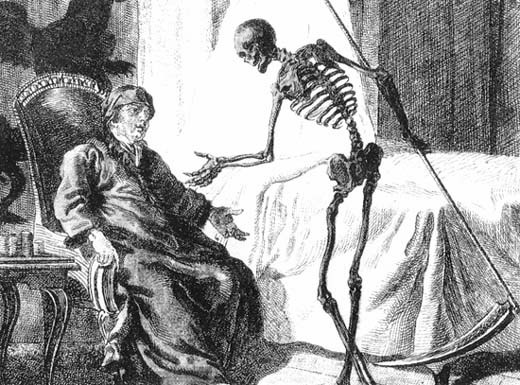Fear the Reaper?
by Kim Pederson…….
At the end of my annual physical exam last week, my doctor congratulated me on my good health report and told me, with a smile, that with such good numbers I would likely live forever. My response? You’re kidding, right? While eternal longevity is appealing in some respects, for many adults, especially in first-world countries with decent, or at least adequate, and somewhat affordable or, if you’re lucky, free health care, this is a scary fiscal prospect and prompts them (well, me anyway) to start checking out the nutritional values of the ninety-nine-cent cans of cat food at the supermarket. According to the Centers for Disease Control, if you are white and male, as of 2015 your life expectancy would be 76.6 years, which means I have about ten years to go. That seems manageable in terms of paying the mortgage, buying food, etc., etc. But forever? That, I’m thinking, would require socialism to run rampant and a Star Trek home replicator.

What prompted me to cogitate about the positive side of mortality, if you can all it that, was a Laughing Squid piece called “A Look at the Idea of Ending Aging and Avoiding Death.” The page features two animations, one titled “End Aging?” and the other “Why Die?” The first video asks why not put an end to the cause of all disease: the process of aging? Aging is caused by physics, it says, not biology. More specifically, it’s wear and tear from “trillions of physical processes.” Our ability to repair the damage they cause diminishes with age. We don’t die of old age, we die “because one of our important parts breaks.” Since we are starting to understand the process of aging better and better, someday we may be able to stop it. Then they get to the real questions: “Should we end aging? Is this a good idea?” They dodge answering, however. (I guess I, the passive reader, am supposed to come with something. Sheesh! What cheek!) Instead, they talk about how one problem now is we wait too long to try to “fix” things and spend most of our health-care dollars on treating age-related diseases rather than preventing them. But even if we did stop aging, we wouldn’t stop death in all the other forms in which it pops up. Or wouldn’t we?
That’s the subject of the second animation, “Why Die?” It starts by asking “When do you want to die? The Reaper is busy, but he can fit you in…right now.” But don’t be scared. The Reaper tells us, it says, “I am your friend,” apparently because he saves us from living too long and wallowing prolongedly in the sad ennui of feeling useless and bored. “Death is a part of life, he whispers. Death gives life meaning.” In response, the narrator tells us that “this is madness.” To end our tendency to think death is inevitable, “brains need to be cleared of the millennia of death acceptance.” Instead, we should view it as just another degenerative disease, one that “infects” everyone, and focus on discovering and building the tools that will make that malady, and the Reaper, a thing of the past.
This assertion seems to comprise a pinch of hunky-dory and a huge dollop of wishfulthinkingness. Don’t expect the Grim Reaper to slink away meekly into the night, never to be seen again. He does have a job, you know, and likely takes it seriously. As Death tells us in Terry Pratchett’s novel Mort,
WHERE THE FIRST PRIMAL CELL WAS, THERE WAS I ALSO, said Death [Death speaks in caps because he has no vocal cords and so the words just appear sonically inside your head “in a voice like lead slabs being dropped on granite”]. WHERE MAN IS, THERE AM I. WHEN THE LAST LIFE CRAWLS UNDER THE FREEZING STARS, THERE WILL I BE.
In “How the Grim Reaper Works,” author William Harris informs us that we humans invented the GR to make sense of death and dying by “giving it a form [we] recognize.” The ancient Greeks came up with Thanatos, a handsome, pleasant young man. The Vikings (yay!) thought the Valkyries, beautiful young women, were a better idea for someone to carry you off to the hereafter. There were also various “angels” of death materializing here and there, including in Europe in the Middle Ages, and that’s where, after all those pesky, depressing plague years, death started being depicted as a skeleton with a black cloak, an hourglass, and a scythe.
Ironically, despite his forbidding appearance, it’s the Grim Reaper that gives most of us the will to put off that last mortal-coil shuffle-off as long as possible. You might think the reason is that simple “consider the alternative” response to “why go on living?” But it’s not that. It’s something better and here it is:
“I meant,” said Ipslore bitterly, “what is there in this world that makes living worthwhile?” Death thought about it. “CATS,” he said eventually. “CATS ARE NICE.”
I couldn’t agree more. As an added bonus, having cats gives you appreciative companions with whom to share your dinner. What will it be tonight, boys? The Tasty Treasures Accented with REAL Bacon or the SauceSations?
Image: A Western depiction of Death as a skeleton wielding a scythe. Public domain.
~~~~~~~~~~
Visit Kim Pederson’s blog RatBlurt: Mostly Random Short-Attention-Span Musings.


Congrats on your latest clean bill of health. That is good news! Fear of death is the germ for so much imaginative anxiety…Various religious afterlives, the vampire and veganism, to name a few. Fugetaboutit… Feliz Dia de los Muertos!